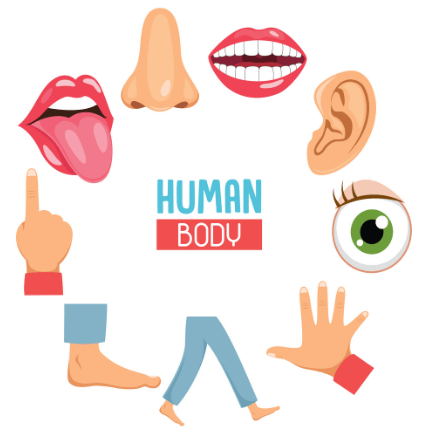
Body Parts Names and Their Functions: The human body functions as a complex machine composed of various interconnected parts, each playing a crucial role in maintaining overall health. At the helm is the brain, serving as the control center that enables thought, emotion, and coordination of bodily functions.
The heart is important for pumping blood throughout the body, delivering oxygen and nutrients that provide energy and support cellular processes. Our lungs facilitate respiration by taking in oxygen and expelling carbon dioxide essential for sustaining life. Bones form the skeletal structure, providing support and protecting vital organs like the brain and heart, much like the frame of a building. The skin, the body’s largest organ, acts as a protective barrier against external threats and allows us to experience sensations like touch, temperature and pain. Muscles are responsible for movement, enabling us to perform everyday activities, from walking to lifting. In this article we will provide a brief overview of these essential body parts and highlights their significance in our daily lives.Human Body Parts Name
 Human body parts consist of various components that work together to sustain life and enable daily activities. These include organs, tissues and structures, each with specific functions that contribute to the body's overall performance.
For example, the
heart
pumps blood, ensuring the distribution of oxygen and nutrients throughout the body, while the
lungs
are responsible for facilitating breathing by exchanging oxygen and carbon dioxide.
The
brain
are the control center, regulating thoughts, emotions, and bodily functions, whereas the
skin
acts as a protective barrier against external elements.
The body is organized into different parts, including the
head
,
forehead
,
eyes
,
ears
,
nose
,
jaw
, and
neck
, which all play vital roles in sensory perception and communication.
The
shoulder
,
arm
,
elbow
,
forearm
,
wrist
and
hand
are essential for movement and manipulation of objects.
The
chest
,
back
,
spine
,
abdomen
, and
navel
house critical organs involved in respiration and digestion. Lower body parts like the
hip
,
buttocks
,
leg
,
thigh
,
knee
,
calf
,
ankle
,
heel
,
foot
,
toes
, and
nails
support mobility and balance.
Each of these body parts varies in size and shape but works in harmony to perform essential tasks for survival. For instance, the
eyes
enable sight, the
ears
facilitate hearing, and the
mouth
assists in eating and speaking.
Human body parts consist of various components that work together to sustain life and enable daily activities. These include organs, tissues and structures, each with specific functions that contribute to the body's overall performance.
For example, the
heart
pumps blood, ensuring the distribution of oxygen and nutrients throughout the body, while the
lungs
are responsible for facilitating breathing by exchanging oxygen and carbon dioxide.
The
brain
are the control center, regulating thoughts, emotions, and bodily functions, whereas the
skin
acts as a protective barrier against external elements.
The body is organized into different parts, including the
head
,
forehead
,
eyes
,
ears
,
nose
,
jaw
, and
neck
, which all play vital roles in sensory perception and communication.
The
shoulder
,
arm
,
elbow
,
forearm
,
wrist
and
hand
are essential for movement and manipulation of objects.
The
chest
,
back
,
spine
,
abdomen
, and
navel
house critical organs involved in respiration and digestion. Lower body parts like the
hip
,
buttocks
,
leg
,
thigh
,
knee
,
calf
,
ankle
,
heel
,
foot
,
toes
, and
nails
support mobility and balance.
Each of these body parts varies in size and shape but works in harmony to perform essential tasks for survival. For instance, the
eyes
enable sight, the
ears
facilitate hearing, and the
mouth
assists in eating and speaking.
Fingers and toes help with grasping objects and maintaining balance. Understanding the functions and importance of these body parts is important for grasping how the human body operates and how to promote overall health and well-being.
List of 50 Body Parts Name
Body Parts Names and Their Functions FAQs
What are the main external body parts?
External body parts include the head, eyes, ears, nose, mouth, arms, legs, hands and feet. They are visible and help us interact with our environment.
What do the eyes do?
The eyes enable us to see and perceive our surroundings. They help us identify colors, shapes and movements.
How do ears help us?
Ears are responsible for hearing sounds and maintaining balance. They detect sound waves and send signals to the brain.
What is the function of the heart?
The heart pumps blood throughout the body, supplying oxygen and nutrients to tissues and organs while removing waste products.
Talk to a counsellorHave doubts? Our support team will be happy to assist you!

Check out these Related Articles
Free Learning Resources
PW Books
Notes (Class 10-12)
PW Study Materials
Notes (Class 6-9)
Ncert Solutions
Govt Exams
Class 6th to 12th Online Courses
Govt Job Exams Courses
UPSC Coaching
Defence Exam Coaching
Gate Exam Coaching
Other Exams
Know about Physics Wallah
Physics Wallah is an Indian edtech platform that provides accessible & comprehensive learning experiences to students from Class 6th to postgraduate level. We also provide extensive NCERT solutions, sample paper, NEET, JEE Mains, BITSAT previous year papers & more such resources to students. Physics Wallah also caters to over 3.5 million registered students and over 78 lakh+ Youtube subscribers with 4.8 rating on its app.
We Stand Out because
We provide students with intensive courses with India’s qualified & experienced faculties & mentors. PW strives to make the learning experience comprehensive and accessible for students of all sections of society. We believe in empowering every single student who couldn't dream of a good career in engineering and medical field earlier.
Our Key Focus Areas
Physics Wallah's main focus is to make the learning experience as economical as possible for all students. With our affordable courses like Lakshya, Udaan and Arjuna and many others, we have been able to provide a platform for lakhs of aspirants. From providing Chemistry, Maths, Physics formula to giving e-books of eminent authors like RD Sharma, RS Aggarwal and Lakhmir Singh, PW focuses on every single student's need for preparation.
What Makes Us Different
Physics Wallah strives to develop a comprehensive pedagogical structure for students, where they get a state-of-the-art learning experience with study material and resources. Apart from catering students preparing for JEE Mains and NEET, PW also provides study material for each state board like Uttar Pradesh, Bihar, and others
Copyright © 2025 Physicswallah Limited All rights reserved.
Get App









